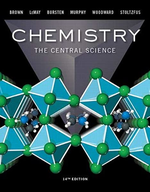?The reaction \(\mathrm{PCl}_{3}(g)+\mathrm{Cl}_{2}(g) \rightleftharpoons
Chapter 15, Problem 15.90(choose chapter or problem)
The reaction \(\mathrm{PCl}_{3}(g)+\mathrm{Cl}_{2}(g) \rightleftharpoons \mathrm{PCl}_{5}(g)\) has \(K_{p}=\) 0.0870 at \(300^{\circ} \mathrm{C}\). A flask is charged with 0.50 atm \(\mathrm{PCl}_{3}, 0.50\) atm \(\mathrm{Cl}_{2}\), and 0.20 atm \(\mathrm{PCl}_{5}\) at this temperature.
(a) Use the reaction quotient to determine the direction the reaction must proceed to reach equilibrium.
(b) Calculate the equilibrium partial pressures of the gases.
(c) What effect will increasing the volume of the system have on the mole fraction of \(\mathrm{Cl}_{2}\) in the equilibrium mixture?
(d) The reaction is exothermic. What effect will increasing the temperature of the system have on the mole fraction of \(\mathrm{Cl}_{2}\) in the equilibrium mixture?
Text Transcription:
PCl_3(g)+Cl_2(g) \rightleftharpoons PCl_5(g)
K_p=
300^circ C
PCl_3
Cl_2
PCl_5
Unfortunately, we don't have that question answered yet. But you can get it answered in just 5 hours by Logging in or Becoming a subscriber.
Becoming a subscriber
Or look for another answer
